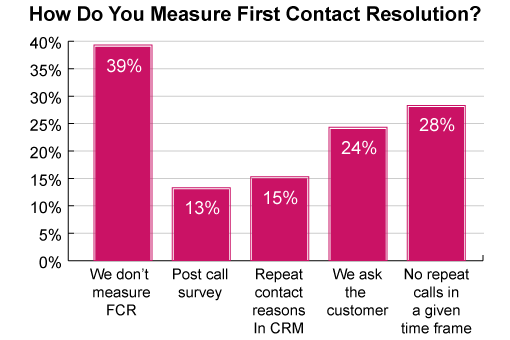Calculating First Contact Resolution (FCR) can be straightforward, once you have the required information, but collecting the data is the tricky part when formulating it.
With this in mind, we will guide you through using the basic FCR calculation and the five ways to collect the data required and ask if there is a better way to measure first contact success.
First Contact Resolution (FCR) Formula
When you measure First Contact Resolution (also known as First Call Resolution), you calculate a percentage by dividing the total of contacts resolved on first contact by the total contacts and then divide that by 100.
First Contact Resolution FCR (%) = Total Contacts Resolved on First Contact ÷ Total Contacts × 100.

For more information on first contact resolution, read our article: What Is First Contact Resolution? – With Formula and Expert Best Practices
5 Ways to Collect FCR Data
Whilst we have heard of other methods to collect the data required to put into the formula above, including using management intelligence information, as well as speech and data analytics, these are five conventional methods of doing so.
1. Asking the Customer on the Call
This method is perhaps the most basic way for how to calculate FCR, as you simply get advisors to ask customers at the end of each call a question along the lines of: “Did the advisor resolve your call satisfactorily?”
Advisors would then record yes or no answers into a database and you would then plug the results into one of the first call resolution formula above.
2. Customer Feedback
There is a range of customer feedback methods, such as mystery shopping, post-call structured telephone interviews and email surveys, which ask a similar question to that above in order to gather data.
Using these approaches will give you a more accurate picture of what is happening, as the customer may not want to tell the advisor that they haven’t resolved their call directly. But it will be difficult to gather enough data to measure at agent level.
If you want ways to collect customer feedback, read our article: 17 Tips for Collecting Customer Feedback
3. No Repeat Calls in a Given Timeframe
This approach makes the assumption that if a customer has not phoned back within a certain time period, which may typically be ten days, their query has been resolved.
So, the number of customers that only call once within the designated space of time would be divided by the total number of calls and then multiplied by 100, as the first formula outlines.
According to our poll, which is shown below, this is the most popular method of calculating FCR.

4. Repeat Contact Reasons
The final traditional method involves pulling repeat contact reasons from your CRM system and then creating individual FCR scores for each reason.
So, once a customer calls about a issue that you are looking to target, you can either ask them if their query has been resolved or measure repeat contacts, to create that individual FCR score that is different from the overall rate.
This approach can be helpful as you can really notice the impact on FCR when you make changes to different process and systems that address the repeat contact reason.
Also, targeting repeat reasons allows you to identify whether the problem is with advisor training or if there is a systemic problem instead of making generalisations based on a generic score.
If you’re confused at the difference between FCR and Repeat contacts, read our article: The Difference Between Measuring Repeat Contacts and First Contact Resolution
5. Using a Dashboard Process
According to Mike Allen, the Founder of Bouncepreneurs, the debate about which way you should collect data is outdated and “now, the debate is what is the right process.”

The process that Mike recommends starts by “identifying your top ten repeat contact reasons, which you can tackle one at a time, focusing on one every two months and then mock up dashboards.”
To dashboard the data in terms of call flows, channel flows and call volumes, Mike advises using a platform such as Alteryx, Tableau or Crowdtech.
These platforms can “create a map around specific contact reasons, picking data up from the customer database, customer mining resources, the company’s website, mobile apps, social media and wherever it is and create an understanding of those individual contact reasons.
“Once this is working, you can plug it into the dashboard, which can run in a liquid form, so the dashboards become real time and live, spanning across all the systems that you have in your business.”
This means that your FCR rates run automatically, with real-time updates, and are more accurate as you are measuring whether the customer has another repeat contact with the business through other means, e.g. social media, logging into an account, etc.
What to Avoid When Using First Contact Resolution
When implementing First Contact Resolution, it’s important to avoid common pitfalls that can distort results and impact service quality. Here are key mistakes to watch out for:
Don’t Pay Advisor Incentives Based on FCR Results
Many businesses ask the question: “Did the advisor resolve your call satisfactorily?”, or words to that effect, to collect data to calculate FCR rates. They would then pay the advisor a bonus based on the customer’s response.
This is a very dangerous thing to do as you are linking your advisor’s pay with systemic failure, which could well be considered ethically incorrect, as you are conflating advisor performance with inherent call resolution failure.
To find out how you can use incentives linked with performance, read our article: How to Use Contact Centre Incentives to Improve Performance
Don’t Set a Timeline When You Measure Repeat Reasons
Each repeat reason has a specific timeline, so don’t set a general timeline to measure the alteration in FCR, as when you make changes to processes, it could take longer to have an impact on FCR rates.
For example, don’t set a 30-day timeline for a monthly statement, as many of the contacts will come after the customers have received their statement, so you won’t be able to record any real change.
If you want to know the best way to measure FCR, read our article: What Is the Best Way to Measure First Contact Resolution?
Don’t Benchmark your FCR Against Others
According to Mike, “inter-organisational FCR comparison, even with those in the same line of business as you, cannot be done accurately.”
This is because, “as soon as you get a slight difference in channel mix (which will vary across all contact centres) FCR goes out of the window, as you have a whole new set of circumstances.”
Also, as there are many ways to gather data for calculating FCR, rates are going to change radically from business to business.
For example, if you ask the caller if their query has been resolved they may say yes but then call back a couple of days later, realising that they forgot to mention something. So, if you calculate FCR by repeat calls, the query would be viewed as unresolved, but it would not be if you went from the question alone.
It is important to make sure you aren’t making other benchmarking mistakes. For more information on this, read our article: Contact Centre Benchmarking – How to Get More From Your Metrics
Don’t Link FCR to Customer Satisfaction
Often, contact centres will link metrics in an attempt to gain an overall picture of their performance. However, this cannot be done with customer satisfaction (CSAT) and FCR as there is little correlation between the two.
According to Mike, “We often have organisations who measure around customer CSAT, with over 90-95% sometimes, whose operational performance KPIs are showing that more than half of the people who ring them are not being served right first time.
“So, despite having repeat contacts, there is no correlation, and the data proves this, between CSAT and FCR.”
Instead, Mike notes that “the data is building month after month, suggesting that CSAT depends a lot on the company’s history, whilst FCR rates do not.
“So, if you have a long-established, loved brand, in a business that people have grown up with, they will actually give a high CSAT score, even though the organisation isn’t servicing their needs very well.”
Don’t Hide FCR Rates from Your Contact Centre Team
Whilst it might make sense to monitor Average Handling Time (AHT) behind the scenes, so advisors are less tempted to compromise service to meet their targets, FCR rates should be published around the contact centre, says Mike.
This is because FCR measures customer service success and that “should be incentivised and advisors should be made aware of it.”
If you are not doing so, and are instead targeting them on other metrics such as AHT, this could be misconstrued by advisors as not putting quality service first.
Don’t Forget “Downstream Issues”
According to the Harvard Business Review, one of the main pitfalls with FCR is that companies with high FCR rates fail to recognise that 22% of repeat callers engage again due to downstream issues from that of the original call.
It’s important for businesses to remember that the customer journey refers to all the interactions a customer has with a brand.

Some services, such as arranging for cable, setting up medical tests or taking out a mortgage, typically take multiple calls to complete.
Anticipating “next steps” and providing guidance on a current call is an excellent way to reduce callbacks for downstream issues.
Contributed by: Frank Sherlock, VP International, CallMiner
How People Manipulate First Contact Resolution
Often, as a metric starts to become central to a contact centre’s operations, businesses will begin to manipulate their results, and FCR has one common manipulation.
This manipulation involves the scenario of when a caller is passed through to another advisor. Is this still a first contact because it is the same call? Or is it a second, due to the fact that the customer is speaking to a second advisor?
Whilst many believe that the second notion is correct as it would be the second advisor that the caller was contacting, many companies will record this as the first contact nonetheless.
So, if the second advisor resolves the call this would still equate to a first contact resolution.
Find out how to improve your FCR rate by reading our article: 20 Tried and Tested Tips to Improve First Call Resolution (FCR)
For more on First Contact Resolution, read our pages on:
- What Is First Contact Resolution? – With a Definition, Formula and Expert Best Practices
- 20 Tried and Tested Tips to Improve First Call Resolution (FCR)
- Podcast: How can you boost First Contact Resolution in your Contact Centre
Author: Jonty Pearce
Reviewed by: Hannah Swankie
Published On: 5th Apr 2017 - Last modified: 15th Aug 2025
Read more about - Customer Service Strategy, Call Handling, CallMiner, Editor's Picks, First Contact Resolution (FCR), Frank Sherlock, How to Calculate, Metrics, Service Strategy









































This is a good article – and shows that FCR is a complex area. FCR is not easy to define – and if you can’t define it you can’t measure it. I agree that comparisons with other organisations is a waste of time – mainly because their definition may be different and their data collection method different too.
What no one seems to measure is what I call TCR – or the Total Calls Required to handle 100 customer issues. What this will give you is a cost measure of FCR. So a 75% FCR might result in 140-150 calls to resolve 100 issues, and remember that follow up calls from customers are often longer. So 70% FCR might mean that your operational resource is at least 50% greater than it would be with 100% FCR.
The purpose of this is to bring into sharp management focus the costs that can be reduced, if any required investment is made in training and coaching, systems, process improvement – and the returns that such investment can generate.
Have a crack at it. You will be surprised at the level of the costs.
Simon
That is a good way to measure First Contact Resolution. It makes a lot of sense.